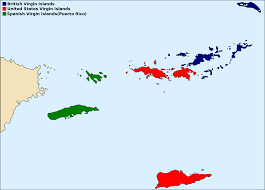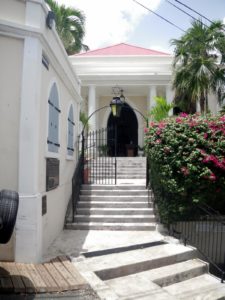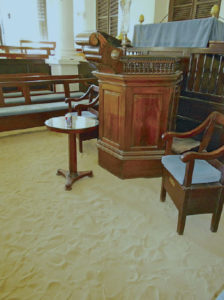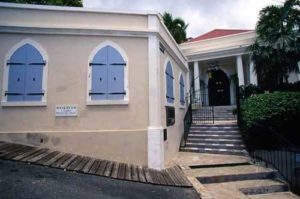 The American Virgin Islands are comprised of: St Thomas, St Croix and St John.
The American Virgin Islands are comprised of: St Thomas, St Croix and St John.
The Dutch controlled St Thomas 1625-1651. Sephardi Jews were granted full equality by the Dutch and were active in establishing the sugar industry and served as administrators, bankers, merchants and helped established markets for the islands’ products. Jews from Denmark first arrived in the Virgin Islands after the Dutch occupation. These were mainly traders in sugarcane, rum and molasses.
 In 1740 it became a free port, and for four decades was an important harbour with the transit trade in the Caribbean, a distinction that St. Thomas harbour would achieve in the following century. The island had attracted a large population of industrious traders from Holland and elsewhere, among them many Jews, mostly of Sephardic origin.
In 1740 it became a free port, and for four decades was an important harbour with the transit trade in the Caribbean, a distinction that St. Thomas harbour would achieve in the following century. The island had attracted a large population of industrious traders from Holland and elsewhere, among them many Jews, mostly of Sephardic origin.
Around 1750, the small Jewish community in Charlotte Amalia invested in a plot of land in Savanne, Kronprindsens Quarter, to establish its own cemetery with the governor’s approval. It is still in existence and is bordered by Jøde Gade, “Jew Street”. The real growth of the Jewish population in the islands of St. Thomas and St. Croix came as a direct result of the destruction of the Jewish community in the nearby Dutch island of St. Eustatius in 1781, which was attacked by the British for having aided the American Revolution.
 In 1796, the Jews of St. Thomas founded a synagogue. In 1801, only nine Jewish families belonged to the congregation but, by 1803, this number had increased to 22, with arrivals from England, France, and the Caribbean islands of St. Eustatius and Curacao. In 1804, the small synagogue was destroyed by fire but was quickly replaced a few years later in 1812.
In 1796, the Jews of St. Thomas founded a synagogue. In 1801, only nine Jewish families belonged to the congregation but, by 1803, this number had increased to 22, with arrivals from England, France, and the Caribbean islands of St. Eustatius and Curacao. In 1804, the small synagogue was destroyed by fire but was quickly replaced a few years later in 1812.
Soon, the congregation grew so large that, by 1823, it was dismantled and a larger building erected in the same location on Synagogue Hill. The Congregation numbered 64 families when a city-wide fire destroyed the synagogue in 1831. In 1833, the current synagogue – Congregation Beracha Veshalom Vegmiluth Hasadim, was built on the same site as first Synagogue, in Charlotte Amalie. The synagogue has a domed ceiling with beautiful chandeliers, mahogany pews and sand floors. During the Spanish Inquisition, Jews who opted to practice Judaism, used sand to muffle the sounds of their prayer. The Altona Cemetery is one of two historic cemeteries owned and maintained by the Hebrew Congregation of St. Thomas. In 1850, the Islands’ Jewish population hit its peak, numbering 400 and making up half of the white community.
 After the opening of the Panama Canal in 1914, the number of Jews declined rapidly and, by 1942, only 50 Jews remained. Since then the community has rebounded and is roughly the size it was at its peak.
After the opening of the Panama Canal in 1914, the number of Jews declined rapidly and, by 1942, only 50 Jews remained. Since then the community has rebounded and is roughly the size it was at its peak.
Today, the synagogue is affiliated with the Reform movement. The low wooden walls in the synagogue served as a mechitzah to separate the women from the men during the early years when the congregation was Orthodox. Since the synagogue is the only one on the island, it serves the religious needs of a diverse Jewish population.
 Jewish colonies were established on St John in 1717 and St Croix, in 1733. While St John has never had a significant Jewish presence, Jews settled in St Croix and built a synagogue there in 1764. This burnt down two years later and was never replaced. There has been a Jewish presence on St. Croix since the 17th century.
Jewish colonies were established on St John in 1717 and St Croix, in 1733. While St John has never had a significant Jewish presence, Jews settled in St Croix and built a synagogue there in 1764. This burnt down two years later and was never replaced. There has been a Jewish presence on St. Croix since the 17th century.
In St. Croix there is a Jewish cemetery, which has graves that are almost 200 years old, as well as some recent ones.
Currently, the Jewish community throughout the islands is 600 full-time residents and an additional 2,000 Jews who reside there during the winter.